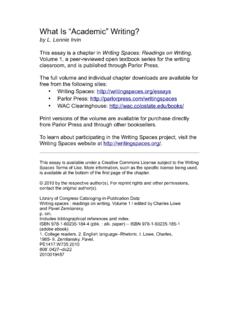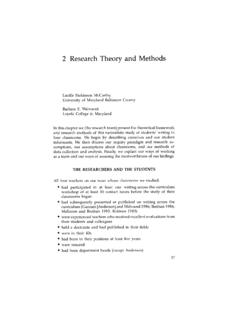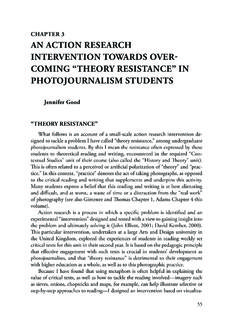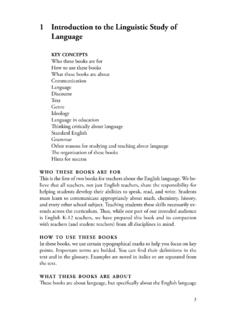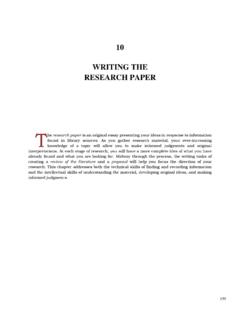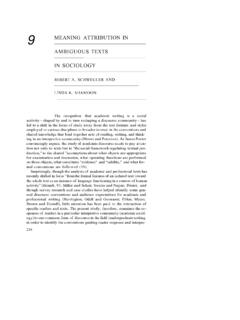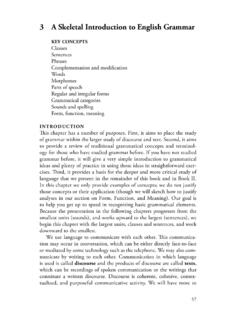Transcription of Diagramming Sentences - WAC Clearinghouse
1 75 7 Diagramming Sentences In the late nineteenth century, Alonzo Reed and Brainerd Kellogg de veloped a method for Diagramming Sentences in the belief that students would understand sentence structure better if they could picture it. Many students do indeed find the diagrams helpful in seeing the rela tionships among sentence elements. (Linguists today, though, prefer another type of diagram that looks like a pyramid.) Here are some sug gestions for using the Reed-Kellogg diagrams in your classes: Use diagrams as you go along teaching grammar so that they become your regular method for illustrating the basic parts of a sentence. Ifyou try to teach Diagramming as an added gram mar lesson after students have already worked at becoming familiar with the concepts, many of them may find it tedious.
2 Sentence Diagramming will test your sense of your students' different learning styles. For students who are visual organiz ers, the diagrams can be very satisfying, an exercise in problem analysis that they enjoy enormously. For others, the spatial ar rangement just doesn't help. You will need to find out which students react in which ways and adjust your assignments and exercises accordingly. Remember that sentence Diagramming (like grammar study in general) is a means to an end, not an end in itself. Teach what will help students make sense of how actual Sentences are or ganized. Sometimes the diagram of just the sentence core-the head of the subject phrase and the head of the main verb phrase-will help students see more clearly.
3 Sentence diagrams can make good collaborative projects. Stu dents can argue about them, make posters of the patterns, or try their hand (if they like diagrams) at Diagramming famous Sentences from the Declaration of Independence, the Gettysburg Address, and so forth, The horizontal line of the diagram has been compared to a spine, with the verb and the whole predicate as the backbone and the subject as the head, Not a perfect metaphor, but one your stu dents might like to work with, 1. The main line of the diagram shows the head noun of the subject di vided from the predicate by a vertical line running through the hori zontal. After the verb, a shorter vertical line divides the verb from the head noun of the direct object.
4 76 Chapter 7 John ~ Ellen Ineeds I help_ I 2. A diagonal line, leaning toward the noun it refers to, precedes the subject or object complement. I : grew ~sleepy They I made I it ~easyI 3. Modifiers appear on diagonal lines below the appropriate words on the main line. Qualifiers are placed on diagonal1ines attached to the modifiers. ~~ard worked ~y" 4. A preposition is placed on a diagonal line beneath the word it modi fies. The object of the preposition appears on a horizontal line attached to the line of the preposition. on El Paso schedule 5. An indirect object is set up like a prepositional phrase because its meaning can be expressed by the prepositions to or for, although the preposition is not written in unless it appears in the sentence.
5 The indi rect object is placed below the verb. 77 Diagramming Sentences 6. Conjunctions appear as dashed lines connecting parallel elements. Joh and I ' love~o~ball Tim I 7. Dashed lines also connect clauses to the main sentence elements that they modify. A relative pronoun is placed in its appropriate slot in the relative (adjectival) clause. Subordinating conjunctions are written on the dashed lines. people I seem\ pleasant I \The: I I I you IHke Ithat I who live on You a street this He I left : \ early : because : he i felt \ sickI . 78 Chapter 7 8. An infinitive phrase-with to followed by a verb with its modifiers and complements-looks similar to a prepositional phrase. Jennifer paper to ~ ~ 9.
6 Phrases and clauses that occupy the subject or complement slot are written on pedestals above the main clause. out of To to shape him when 79 Diagramming Sentences 10. The two clauses of a compound sentence are connected with a dashed line from verb to verb, with the conjunction on a solid line be tween the two. tidy ' :.., I \yard IS I mess \ the This description of Diagramming , from KaHn and Funk's Under standing English Grammar, includes slight variations from the original Reed and Kellogg diagrams. KaHn and Funk's text also includes dia grams of many other, and more complex, grammatical structures. 80 8 An Overview of Linguistic Grammar The purpose of this chapter is to acquaint you with concepts of lin guistic grammar that you may find useful in your teaching.
7 We are using the term linguistic grammar to distinguish this descrip tion from that of traditional grammar, the Latin-based description that has dominated school grammar for several centuries. We are not sug gesting that you substitute this grammar for what is already familiar to you. Rather, we hope that you'll find either additional or alternative ways of describing the structure of Sentences , ways that take advantage of our subconscious knowledge of language structure. Word Classes When linguists looked at English Sentences objectively, rather than through the lens of Latin, with its eight parts of speech, they classified words into two broad categories: 1. Form classes: nouns, verbs, adjectives, and adverbs.
8 These "open" classes, which constitute perhaps 99 percent of our lan guage, are open to new members, with nouns and verbs and adjectives and adverbs entering the language as new technol ogy and new ideas require them. 2. Structure classes: determiners, auxiliaries, qualifiers, preposi tions, conjunctions, and pronouns. In general, these are the "closed" classes; they remain constant. While it's true we no longer hear whilst and betwixt and thy, we have managed with the same fairly small store of structure words that Shakespeare used. Al though the form classes have more members, the struc ture classes are by far the most frequently used; in fact, our twenty most frequently used words are all structure- class words.
9 Another difference between the two classes is their function in the sentence: the form classes provide the primary lexical meaning, while the structure classes provide the grammatical, or structural, rela tionships. We can compare the two classes to the bricks and mortar of a building: the form classes are the bricks, the structure classes the mor tar that holds them together. Consider, for example, lines from lewis Carroll's "Jabberwocky": 81 An Overview of Linguistic Grammar Twas brillig and the slithy toves Did gyre and gimble in the wabe All of the nonsense words are form- class words; their form and their position, of course, help give them meaning. But without the structure words, "Jabberwocky" would have no meaning at all: brillig slithy toves gyre gimble wabe Notice, too, that when you read these words without the clues of the structure words, the Sentences (if you can call them that) lose their rhythm.
10 Most structure words are unstressed: they have the lowest vol ume and pitch, providing valleys between the peaks of loudness that fall on the stressed syllables of form- class words. As native speakers, or experienced second language speakers, we don't have to pay much attention to the structure classes, but we certainly miss them when they're gone. And they are no doubt the most difficult for non-native speakers to master. The Form Classes Nouns, verbs, adjectives, and adverbs get the label "form classes" be cause they have inflectional forms (such as verbs with tense endings) and derivational forms (those with prefixes and some suffixes) that dif ferentiate them from one another as well as from the other classes.

